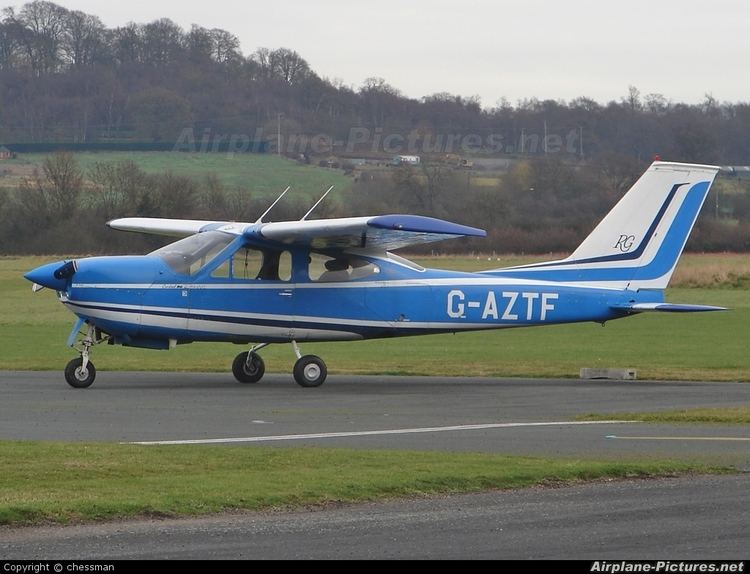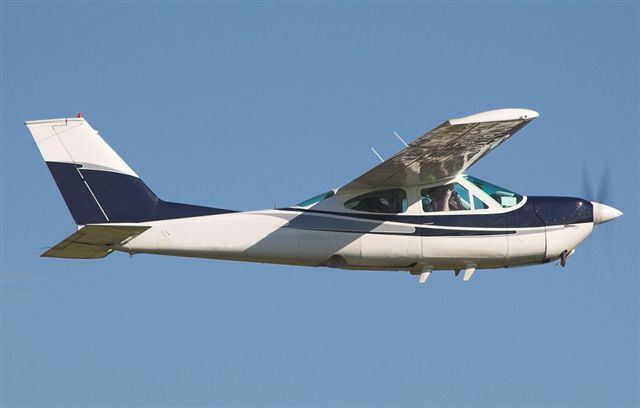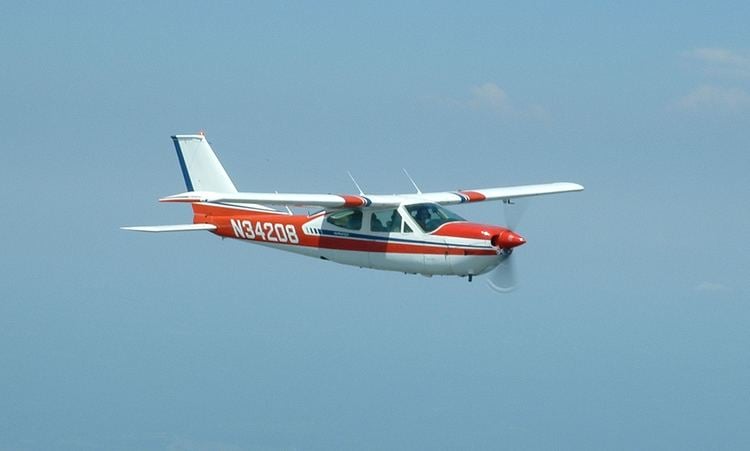Cruise speed 210 km/h Top speed 252 km/h Weight 680 kg | Wingspan 11 m Range 1,215 km Unit cost 27,250–27,250 USD (1976) | |
 | ||
The Cessna 177 Cardinal is a light single-engine, high-wing general aviation aircraft that was intended to replace Cessna's 172 Skyhawk. First announced in 1967, it was produced from 1968 to 1978.
Contents
- Cessna 177 cardinal takeoff
- Development
- Performance and handling problems
- Cessna 177A
- Cessna 177B
- Cessna 177RG
- Notable accidents and incidents
- Specifications Cessna 177B
- References

Cessna 177 cardinal takeoff
Development

The Cessna 177 was designed in the mid-1960s when the engineers at Cessna were asked to create a "futuristic 1970s successor to the Cessna 172". The resulting aircraft featured newer technology such as a cantilever wing lacking the lift struts of previous models, and a new laminar flow airfoil. The 177 is the only production high-wing single-engined Cessna since the Cessna 190 & 195 series to have both fixed landing gear and a cantilever wing without strut bracing.

In 1971, Cessna experimented with a "Quiet Cardinal" similar to the Beechcraft QU-22 Pave Eagle. A test model was flown with a Wankel engine with a large three bladed 100 inch diameter propeller with a belt driven gear reduction unit and a fuselage-length exhaust canted upward.

The 1968 model 177 was introduced in late 1967 with a 150 hp (112 kW) engine. One of the design goals of this 172 replacement was to allow the pilot an unobstructed view when making a turn. In the 172 the pilot sits under the wing and when the wing is lowered to begin a turn that wing blocks the pilot's view of where the turn will lead to. The engineers resolved this problem by placing the pilot forward of the wing's leading edge, but that led to a too-far-forward center of gravity.
This problem was partially counteracted by the decision to use the significantly lighter Lycoming O-320 four-cylinder engine in place of the six-cylinder O-300 Continental used on the 172. The forward CG situation still existed even with the lighter engine, so a stabilator was chosen, to provide sufficient elevator control authority at low airspeeds.
The 177 design was intended to be a replacement for the 172, which was to be discontinued after introduction of the new aircraft. The new design was originally to be called the 172J (to follow the 1968 model 172I). However, as the time came to make the transition, there was considerable resistance to the replacement of the 172 from the company's Marketing Division. The 1969 172 jumped to the designator 172K—there is no 172J.
The 177 offers much better upward visibility than a 172 because of its steeply raked windshield and more aft-mounted wing. The absence of an obstructing wing support strut also makes the aircraft an excellent platform for aerial photography.
Performance and handling problems
Soon after delivery of the first Cardinals to customers there were reported incidents of pilot-induced oscillation (PIO) that alarmed Cessna enough that the factory initiated a priority program to eliminate the problem. Reviewer Joe Christy explains:
We liked that airplane, and found almost nothing to pick at. However, owners soon discovered to their horror that it didn't fly or land exactly like a strutless Skyhawk, and some heavy-handed Super-Car drivers managed to smash the Cardinal tail into the pavement on landing, knock-off a few nose-wheels, etc. (apparently, this was possible if one closed his eyes, used full back-pressure on the wheel at the flare and then sat rigidly waiting for the crashing noises to subside). Cessna accepted the blame gracefully. That was proper because, after all, they had lulled a generation of Cessna pilots into near-effortless flying with the extremely forgiving 172 series, and it probably wasn't ethical to suddenly offer, to many of those same customers, a Cessna that didn't handle exactly like a Cessna. The company therefore picked up the tab for a list of modifications that gentled the Cardinal and returned the smiles to the faces of dealers and customers.
The solution, which was provided to all aircraft already delivered at no cost, was known as Operation "Cardinal Rule" and included a series of 23 inspection, installation, and modification instructions. This Service Letter, SE68-14, consisted of modifying the stabilator to install slots just behind the leading edge (to delay the onset of stabilator stall) and installing full counterbalance (11 pounds versus the original 7 pounds) on the stabilator to eliminate the PIO problem.
The 177, with its 150 hp (112 kW) powerplant, was considered "underpowered", even though it had more power than the 145 hp (108 kW) Cessna 172.
Cessna 177A
Recognizing that the aircraft was underpowered, Cessna introduced the 177A in 1969. The revision featured a 180 hp (135 kW) four-cylinder Lycoming O-360, moving the design's price and role somewhere between that of the 172 and 182. The additional power improved cruise speed by 11 knots (20 km/h).
Cessna 177B
1970 saw the introduction of the 177B, which had a new wing airfoil, a constant-speed propeller, and other minor improvements. When empty, the 177B weighed 145 lb (66 kg) more than the earlier 177, with its maximum takeoff weight increased from 2,350 lb (1,067 kg) to 2,500 lb (1,135 kg).
In 1978, Cessna built a deluxe version of the 177B, the Cardinal Classic, with leather upholstery, a table for the rear passengers, and a 28-Volt electrical system.
Cessna 177RG
The final aircraft in the 177 line was the retractable-gear 177RG Cardinal RG, which Cessna began producing in 1971 as a direct competitor to the Piper PA-28-200R Cherokee Arrow and Beechcraft Sierra. The nose gear folds rearward; when opened the gear door formed a small air brake behind the propeller.
To offset the 145 lb (66 kg) increase in empty weight, much of which was from the electrically powered hydraulic gear mechanism, the 177RG had a 200 hp (149 kW) Lycoming IO-360 engine. This also allowed increase of the maximum weight by 300 lbs.
The additional power and cleaner lines of the 177RG resulted in a cruise speed of 148 kn (274 km/h), 22 kn (41 km/h) faster than the 177B. 1,543 177RGs were delivered between the US and Reims, Cessna's licensed partner in France. Those built in France by Reims were referred to as the Reims F177RG.
Notable accidents and incidents
Specifications (Cessna 177B)
Data from Airliners.net
General characteristics
Performance
